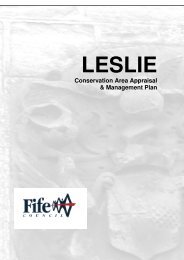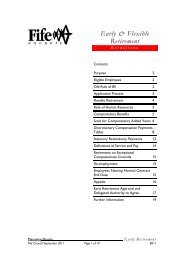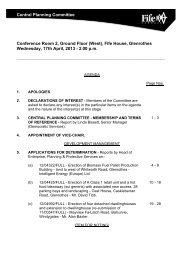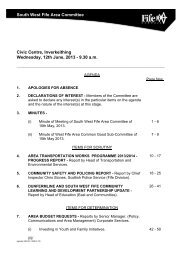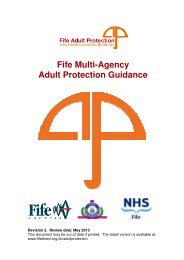An Economic Profile of the Glenrothes Area - Home Page
An Economic Profile of the Glenrothes Area - Home Page
An Economic Profile of the Glenrothes Area - Home Page
You also want an ePaper? Increase the reach of your titles
YUMPU automatically turns print PDFs into web optimized ePapers that Google loves.
4. Trends in Descriptive Statistics4.1. Prevalence <strong>of</strong> Child Adoption, 1880-1930 & 2000How common was adoption in <strong>the</strong> late 19th century? Did adoption become more popular in <strong>the</strong> early20th century in response to less stigma and wider social acceptance? Table 1 reports <strong>the</strong> estimatednumbers <strong>of</strong> biological, adopted, step, and foster children in U.S. households in 1880-1930 and 2000.Alaska and Hawaii are excluded from all years to maintain consistency across years. Although I includeNative Americans and Asians in <strong>the</strong> table, due to small sample size, estimates for <strong>the</strong>se races areunreliable in early census years. Throughout this paper, child is defined as any person under age 18 (age0 to 17) residing in a household whose relationship to <strong>the</strong> household head is reported as “child,”including biological, step, and adopted children. I also include foster children in <strong>the</strong> table even thoughfoster child is reported (not as “child” but) as co-resident nonrelatives in IPUMS. 8 It must be noted that<strong>the</strong> child type is always defined in relation to household head, while <strong>the</strong> relationship between a childand a spouse <strong>of</strong> <strong>the</strong> household head is not directly identified. For example, consider <strong>the</strong> case <strong>of</strong> marriedtwo-parent households with children. In 1880-1930, in virtually all such households <strong>the</strong> household headis children’s fa<strong>the</strong>r and not mo<strong>the</strong>r. In <strong>the</strong>se households, children are labeled “biological” if <strong>the</strong>y have abiological fa<strong>the</strong>r, regardless <strong>of</strong> <strong>the</strong>ir relationship to a mo<strong>the</strong>r. Thus, in our definition, biological childreninclude not only children who have two birth parents but also those who have a biological fa<strong>the</strong>r and astepmo<strong>the</strong>r. Similarly, children are labeled “adopted” when <strong>the</strong>y have an adoptive fa<strong>the</strong>r even if <strong>the</strong>irmo<strong>the</strong>r is a biological or step mo<strong>the</strong>r. As a result, adopted children in our definition include adoptedstepchildren (as in <strong>the</strong> case <strong>of</strong> a remarried husband adopting his wife’s biological children from herprevious marriage). 9 Accordingly, step children in our definition exclude children <strong>of</strong> a biological fa<strong>the</strong>rand a stepmo<strong>the</strong>r. Because our definitions <strong>of</strong> biological and adopted children overlap with“stepchildren” in its common usage <strong>of</strong> <strong>the</strong> term, for comparison, I keep step children (in our definition)as a child type throughout <strong>the</strong> paper.According to Table 1, in 1880-1930, on average 0.26% <strong>of</strong> white children under age 18 in allhouseholds were adopted, compared to 2.2% in 2000. Although 0.26% may seem small, given <strong>the</strong> factthat even in 2000 when adoption seems ubiquitous <strong>the</strong> adopted children were only 2% <strong>of</strong> all children, itshows that adoption was surprisingly common in <strong>the</strong> earlier period. I find, however, no positive trend in<strong>the</strong> share <strong>of</strong> adopted children from 1880 to 1930 among whites. This could be that <strong>the</strong> literature’semphasis on a rising demand for agency adoption has been misplaced or that such increase was <strong>of</strong>fset8 Foster children refer to children who are temporarily cared for by foster parents while <strong>the</strong>ir birth parents are unable toperform parental duties due to financial, medical, or emotional reasons. Unlike adoptive parents, foster parents do not assumeparental rights. Historically, however, <strong>the</strong>se two concepts were not well differentiated.9 Note, however, that our definition <strong>of</strong> adopted children excludes those who are reported as a household head’s “adoptedbro<strong>the</strong>r (or sister),” “adopted nephew (or niece),” and “adopted grandson (or granddaughter)” even if <strong>the</strong>y are under age 18.6



